
FM 21-150 COMBATIVES 1992
.pdf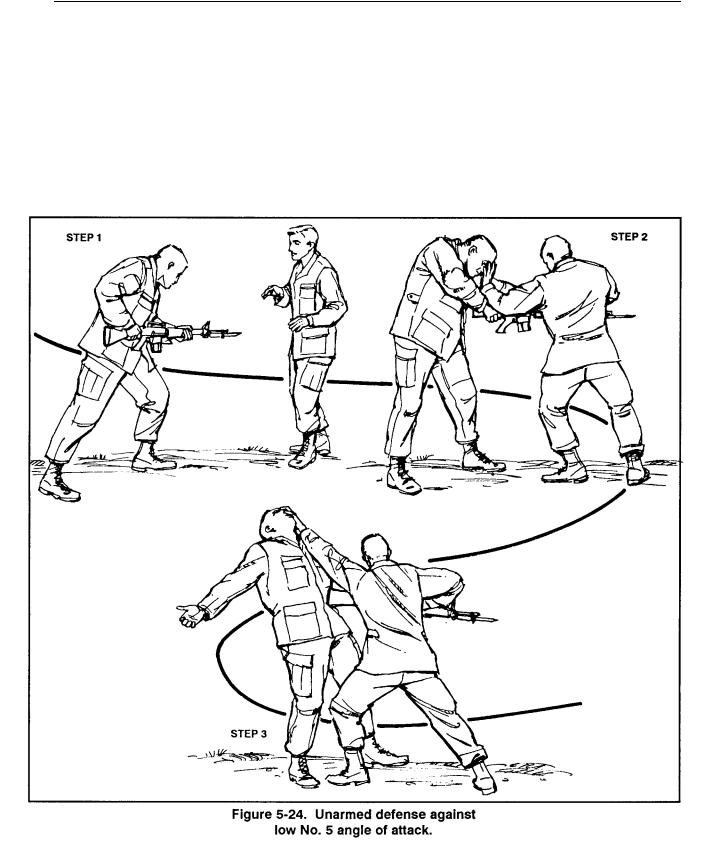
FM 21-150
(5) Unarmed defense against low No. 5 angle of attack. The attacker thrusts the bayonet at the stomach of the defender (Figure 5-24, Step 1).
The defender shifts his body to the side to avoid the attack and to gouge the eyes of the attacker (Figure 5-24, Step 2).
The defender’s free hand maintains control of and strips the weapon from the attacker as he is driven backward with the eye gouge (Figure 5-24, Step 3).
5-38

FM 21-150
(6) Unarmed defense against high No. 5 angle of attack. The attacker delivers a thrust to the throat of the defender (Figure 5-25, Step 1).
The defender then shifts to the side to avoid the attack, parries the thrust, and controls the weapon with his trail hand (Figure 5-25, Step 2).
He then shifts his entire body mass forward over the lead foot, slamming a forearm strike into the attacker’s throat (Figure 5-25, Step 3).
5-39
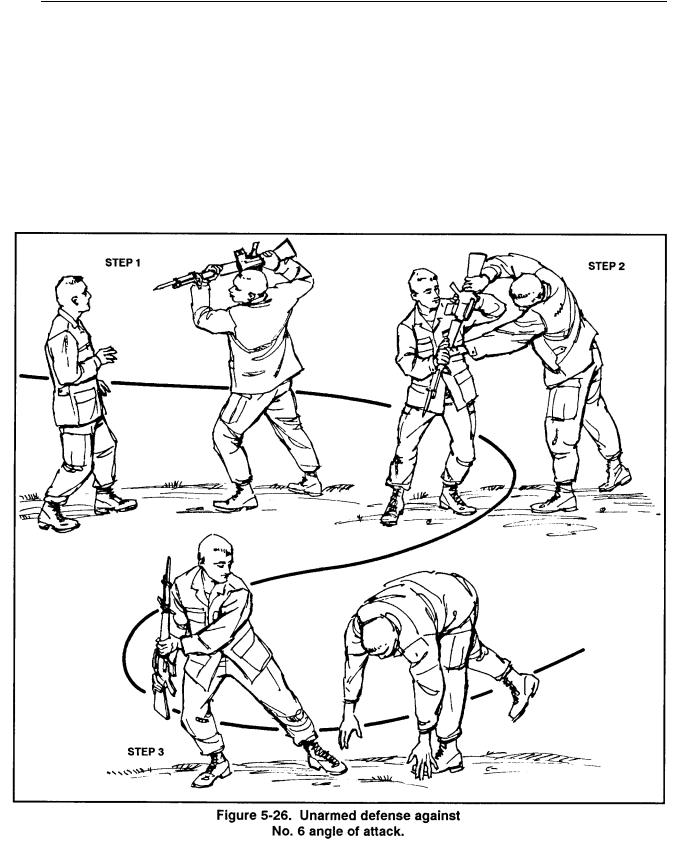
FM 21-150
(7) Unarmed defense against No 6 angle of attack. The attacker delivers a downward stroke along the No. 6 angle of attack (Figure 5-26, Step 1).
The defender shifts to the outside to get off the line of attack and he grabs the weapon. Then, he pulls the attacker off balance by causing him to overextend himself (Figure 2-26, Step 2).
The defender shifts his weight backward and causes the attacker to fall, as he strips the weapon from him (Figure 5-26, Step 3).
.
5-40

FM 21-150
5-7. ADVANCED WEAPONS TECHNIQUES AND TRAINING
For advanced training in weapons techniques, training partners should have the same skill level. Attackers can execute attacks along multiple angles of attack in combinations. The attacker must attack with a speed that offers the defender a challenge, but does not overwhelm him. It should not be a contest to see who can win, but a training exercise for both individuals.
a.Continued training in weapons techniques will lead to the partners’ ability to engage in free-response fighting or sparring—that is, the individuals become adept enough to understand the principles of weapons attacks, defense, and movements so they can respond freely when attacking or defending from any angle.
b.Instructors must closely monitor training partners to ensure that the speed and control of the individuals does not become dangerous during
advanced training practice. Proper eye protection and padding should be used, when applicable. The instructor should stress the golden rule in free-response fighting—Do unto others as you would have them do unto you.
Section III
OFFENSIVE TECHNIQUES
At ranges of 10 meters or more in most combat situations, small arms and grenades are the weapons of choice. However, in some scenarios, today’s combat soldier must engage the enemy in confined areas, such as trench clearing or room clearing where noncombatants are present or when silence is necessary. In these instances, the bayonet or knife may be the ideal weapon to dispatch the enemy. Other than the side arm, the knife is the most lethal weapon in close-quarter combat.
5-8. BAYONET/KNIFE
As the bayonet is an integral part of the combat soldier’s equipment, it is readily available for use as a multipurpose weapon. The bayonet produces a terrifying mental effect on the enemy when in the hands of a well-trained and confident soldier. The soldier skilled in the use of the knife also increases his ability to defend against larger opponents and multiple attackers. Both these skills increase his chances of surviving and accomplishing the mission. (Although the following paragraphs say “knife,” the information also applies to bayonets.)
a. Grips. The best way to hold the knife is either with the straight grip or the reverse grip.
(1) Straight Grip. Grip the knife in the strong hand by forming a vee and by allowing the knife to fit naturally, as in gripping for a handshake.
5-41
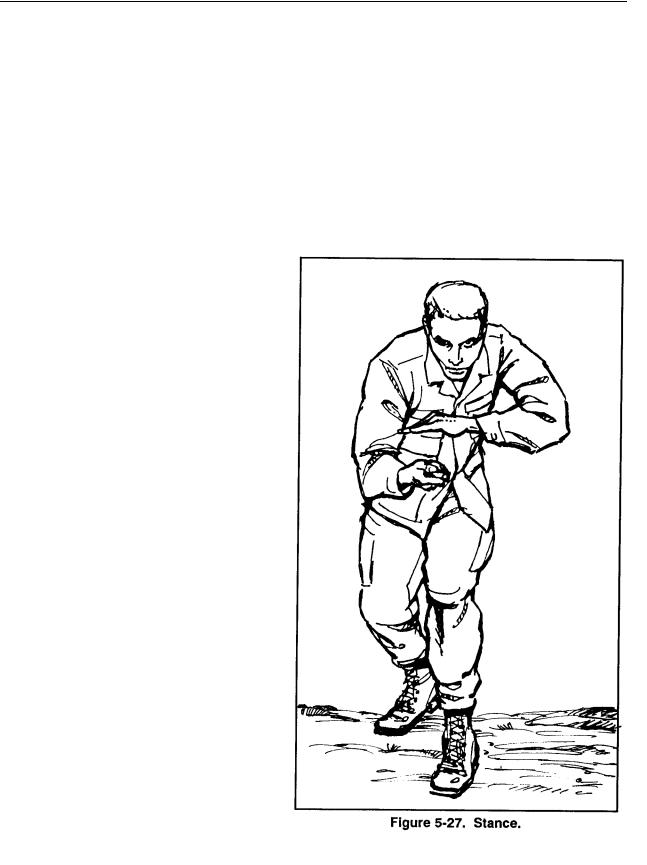
FM 21-150
The handle should lay diagonally across the palm. Point the blade toward the enemy, usually with the cutting edge down. The cutting edge can also be held vertically or horizontally to the ground. Use the straight grip when thrusting and slashing.
(2) Reverse Grip. Grip the knife with the blade held parallel with the forearm, cutting edge facing outward. This grip conceals the knife from the enemy’s view. The reverse grip also affords the most power for lethal insertion. Use this grip for slashing, stabbing, and tearing.
b. Stances. The primary stances are the knife fighter’s stance and the
modified stance.
(1) Knife fighter’s
stance. In this stance, the fighter stands with his feet about shoulder-width apart, dominant foot toward the rear. About 70 percent of his weight is on the front foot and 30 percent on the rear foot. He stands on the balls of both feet and holds the knife with the straight grip. The other hand is held close to his body where it is ready to use, but protected (Figure 5-27).
5-42
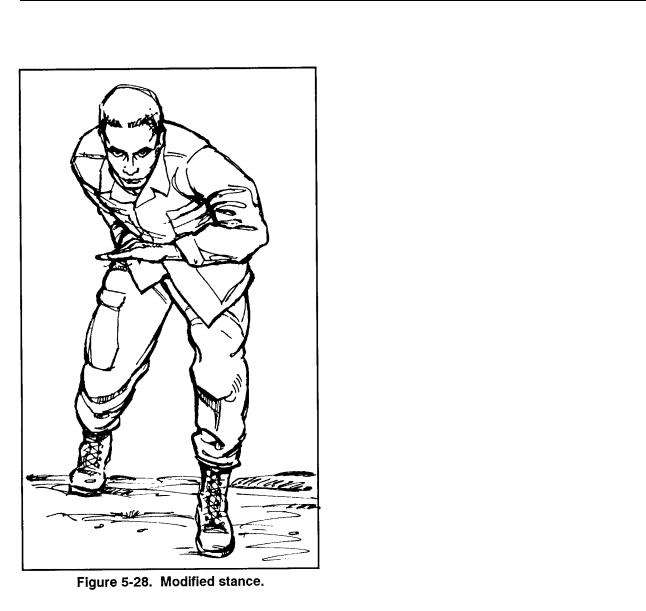
FM 21-150
(2) Modified stance. The difference in the modified stance is the knife is held close to the body with the other hand held close over the knife hand to help conceal it (Figure 5-28).
c. Range. The two primary ranges in knife fighting are long range and medium range. In long-range knife fighting, attacks consist of figure-eight slashes along the No. 1, No. 2, No. 7, and No. 8 angles of attack; horizontal slashes along the No. 3 and No. 4 angles of attack; and lunging thrusts to vital areas on the No. 5 angle of attack. Usually, the straight grip is used. In medium-range knife fighting, the reverse grip provides greater power. It is used to thrust, slash, and tear along all angles of attack.
5-43

FM 21-150
5-9. KNIFE-AGAINST-KNIFE SEQUENCE
The knife fighter must learn to use all available weapons of his body and not limit himself to the knife. The free hand can be used to trap the enemy’s hands to create openings in his defense. The enemy’s attention will be focused on the weapon; therefore, low kicks and knee strikes will seemingly come from nowhere. The knife fighter’s priority of targets are the eyes, throat, abdominal region, and extended limbs. Some knife attack sequences that can be used in training to help develop soldiers’ knowledge of movements, principles, and techniques in knife fighting follow.
a. Nos. 1 and 4 Angles. Two opponents assume the knife fighter’s stance (Figure 5-29, Step 1).
The attacker starts with a diagonal slash along the No. 1 angle of attack to the throat (Figure 5-29, Step 2).
He then follows through with a slash and continues with a horizontal slash back across the abdomen along the No. 4 angle of attack (Figure 5-29, Step 3).
He finishes the attack by using his entire body mass behind a lunging stab into the opponent’s solar plexus (Figure 5-29, Step 4).
5-44
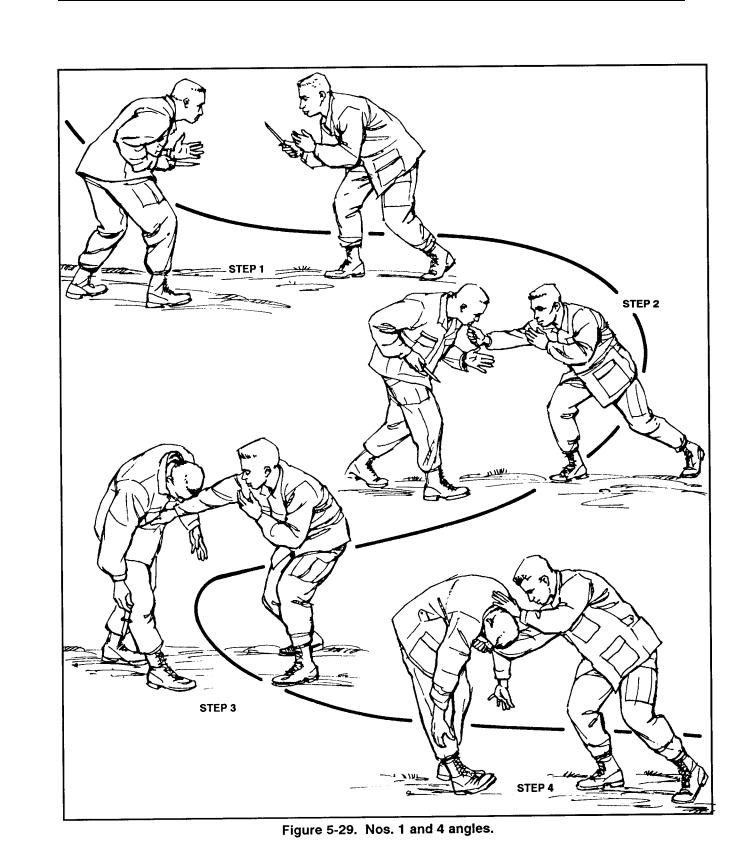
FM 21-150
5-45

FM 21-150
b. Nos. 5, 3, and 2 Angles. In this sequence, one opponent (attacker) starts an attack with a lunge along the No. 5 angle of attack. At the same time, the other opponent (defender) on the left moves his body off the line of attack, parries the attacking arm, and slices the biceps of his opponent (Figure 5-30, Step 1).
The defender slashes back across the groin along the No. 3 angle of attack (Figure 5-30, Step 2).
He finishes the attacker by continuing with an upward stroke into the armpit or throat along the No. 2 angle of attack (Figure 5-30, Step 3). Throughout this sequence, the attacker’s weapon hand is controlled with the defender’s left hand as he attacks with his own knife hand.
5-46
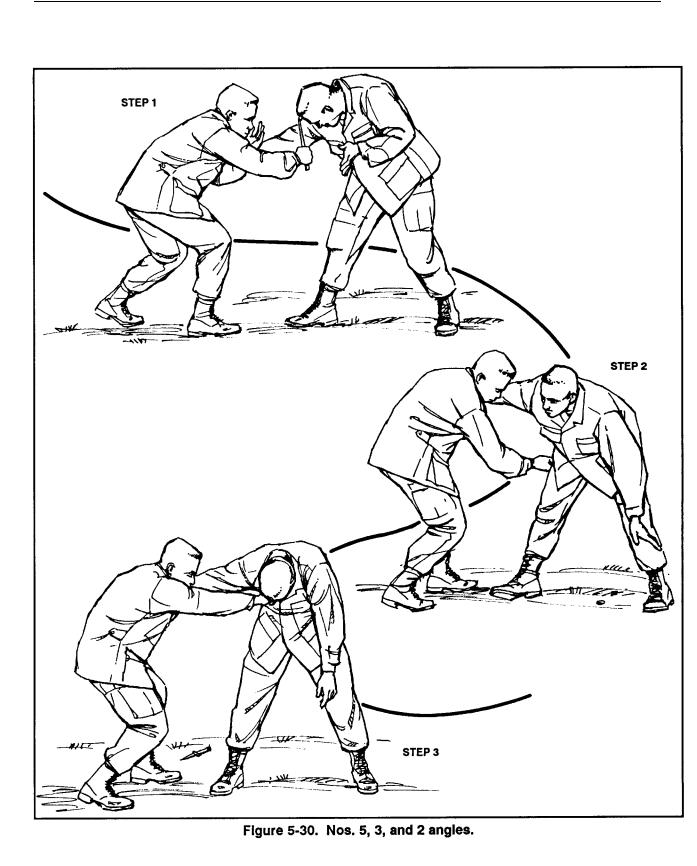
FM 21-150
5-47
